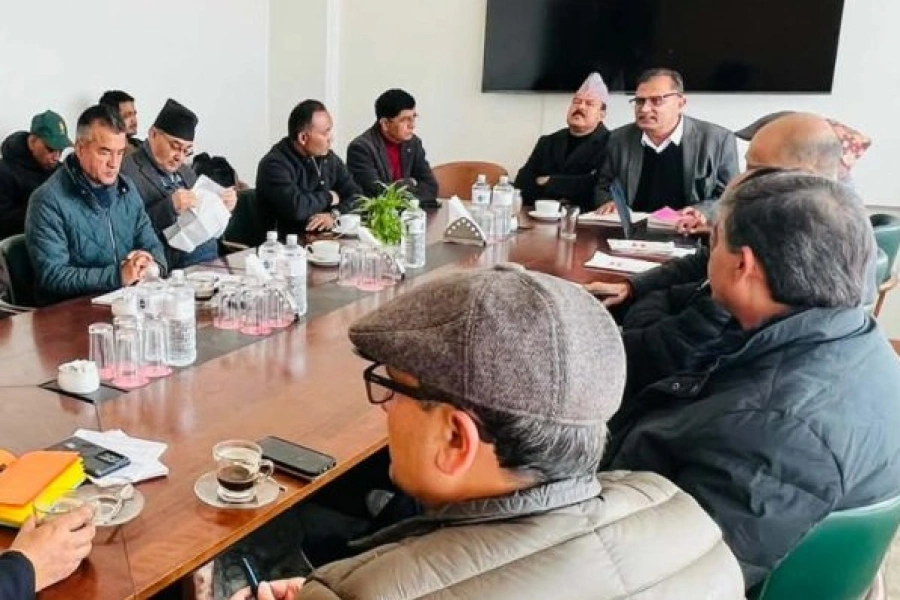They call it transitional style. The marriage between traditional Nepali and modern interior results in elegant and enduring designs and it’s a theme that interior designers like Sapana Bhusal, from Bella Casa, are often requested for by their clients.
“When you mix traditional and modern schemes in your interior you have these opposing elements and it makes for quite the impact,” says Bhusal. Since this is a trend that seems to be only growing in demand, Bhusal talks about making regular trips around local areas like Bhaktapur and Patan as well as making a point to observe traditional aesthetic while on trips abroad for inspiration.
As she put it, “Even though, you are visiting the same place multiple times, in my experience, you notice new details and get new ideas on each trip. Such is the vastness of cultural and historical designs.”
However, Bhusal also has a word of caution. The trick with transitional style is to always make it appear seamless and, according to her, that’s where many people tend to stumble.
“If you think putting an aakhi jhyal in the middle of your sitting room is enough, you are wrong,” she explains. “Many people tend to randomly put a couple traditional decorations around their room but the proper way to do it is with a touch of subtlety.” She stresses on coordinating your interior in such a way that transitional style becomes a running theme of your room. So, for instance, don’t only pay attention to the displays but also details like the color (in Nepali essence, neutral shades of clay or maroon), the seating arrangements and so on.
This can certainly prove to be confusing for many novices out there so Bhusal shares a few pointers with The Week.
Oscars 2019: Full list of winners

Don’t overdo it
First thing first, practice constrain. If you put Nepali carvings all around your furniture and frames then that gives your interior a traditional look. Recognize the difference between a completely traditional interior and a mix i.e. the transitional style between traditional and modern.
“For example, if you like the look of aakhi jhyal,” says Bhusal, “you don’t need to make one for your rooms. Instead try to draw inspiration from the design and recreate certain aspects of it. Perhaps, you could craft the corners or the midsection of your windows in that fashion. The point is to not copy but bring about a modern interpretation.”
Pick the right materials
What you use to decorate your space is essential to the vibe you want to create. When it comes to drawing inspiration from traditional Nepali aesthetics, décor made of materials like bronze and cooper always help make the right impact.
But your options aren’t only limited to metal. You can be creative with small aspects of your decor like cushion covers as well. By using fabrics like dhaka or velvet or even putting on rhododendron patterns on them can help your interior harness that traditional feel. But again, practice constraint. Don’t overdo it. Just throw a couple of cushions in dhaka covers among your other cushions. Just make sure the colors or patterns, on the whole, complement one another.
Materials count when you are trying to make your structures as well. Adding dalin to the ceiling, Bhusal says, is a popular trend at the moment. Originally, these dalin used to be made of heavy wood. Such structure, however, might not fit the look of contemporary spaces. So in these cases, you can ask for alternative materials that are much lighter. This will give the feel of traditional design without overwhelming the contemporary aesthetic.
Pay attention to the details of the displays
As many might have already figured out, displays are an important factor of transitional interior design. You want to preserve the simple, neutral lines and color schemes while incorporating the intricate details of traditional aesthetics. Also, since we want the mix to look seamless, you want to not only focus on the main displays but also the small ones that can easily be ignored.
Bhusal gives us an example of dustbins. Indeed, they matter. Rather than using plastic bins, you can use ones made of clay or baskets made of choya. Little things likes this goes a long way to add aesthetic value to your room and bring out that traditional and modern mix vibe that you are going for. The same principle applies for your flower pots, the taps of your washroom or the handles of your doors and windows as well. Noting these tiny details is very important in establishing the theme of your room.
Another example could be the wall decoration. You could have a painting that depicts the culture and history of our country, but they can very well fail to make the impact you want if you put them in metal or steel frames. For transitional décor style, Bhusal suggests using wooden frames with carvings or something similar that appeals to Nepali design.
If you wander through the markets of Ason or Patan, you are bound to spot many of these trinkets. For instance, wind chimes made from clay or the panas, for the lights. One may consider these to be new designs but they have been available in these markets for many decades now. You are bound to find inspiration while strolling through them.
Similarly, another popular item in these markets are silver or bronze utensils. We are talking about karuwa, ghaita and such. You may have noticed that, traditionally, Nepalis have always used them more for decoration. Knowing these cultural details always helps.
Instead of using statues or modern crockery, you can find such nicely engraved utensils to complement your space. They are easily available in our markets, and if you want to go a step further and use silver or gold utensils, the jewelry shops also widely offer these services.
Never too early to start
Bhusal shares that there are always challenges in striking the right balance and in case you are actually building your house or your rooms from scratch, she even suggests that you consult an interior designer from the start.
“If a building or a room has modern layouts, we have to make a few compromises when going traditional,” she says. “It’s easier if you build your structure by keeping the traditional aspects in mind. Things like dome shaped doors, for example, will look so much better with wooden carvings than the straight lines of modern doorways. By consulting an expert from the get-go, you get a head start,” she concludes.




































